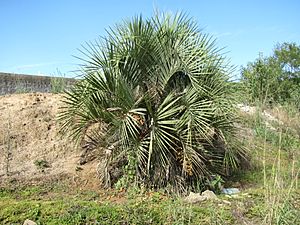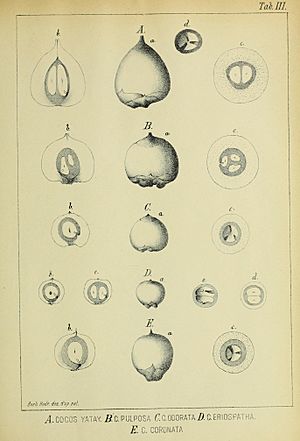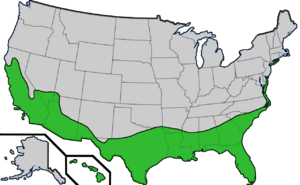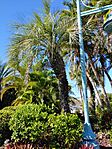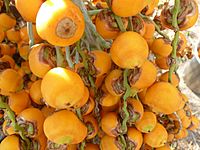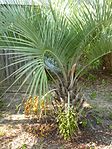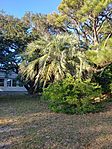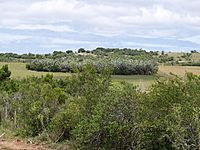South American jelly palm facts for kids
The Pindo Palm, also called the Jelly Palm (its scientific name is Butia odorata), is a type of palm tree. It grows naturally in the southern parts of Brazil and Uruguay. This palm grows slowly and can reach up to 10 meters (about 33 feet) tall, but it's often shorter. You can spot it by its feathery leaves that curve inwards, forming a thick, strong trunk.
Quick facts for kids South American jelly palm |
|
|---|---|
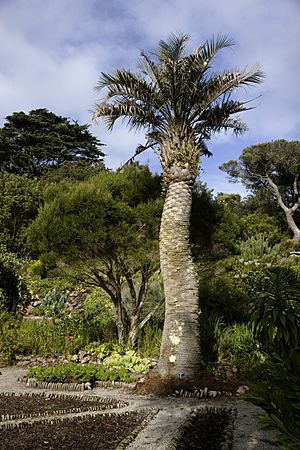 |
|
| Butia odorata, a Pindo Palm, growing in Tresco, Isles of Scilly, UK | |
| Scientific classification | |
| Genus: |
Butia
|
| Species: |
odorata
|
| Synonyms | |
|
|
Contents
About the Pindo Palm
These palms are often called Butia capitata in plant stores. For a long time, people thought it was the same species as a more tropical palm. Many gardens and nurseries still use the old name. This can be confusing!
In Rio Grande do Sul, Brazil, locals call this plant butiá-da-praia or simply butiá.
Why the Name Odorata?
The name odorata comes from a Latin word meaning 'perfumed'. João Barbosa Rodrigues chose this name in 1891. He wanted to show how wonderfully fragrant the fruit is. At that time, it was thought to be one of the best palm fruits to eat in Brazil.
How Scientists Classify It
Until 2011, this palm was grouped with Butia capitata. That species was first described in 1826. A palm expert named Larry R. Noblick noticed that the B. capitata he saw in the wild was different from the B. odorata grown in gardens. He realized they were two separate species.
Noblick tried to separate them a few times. He finally succeeded in 2011. He used the oldest name given to this specific palm: Cocos odorata.
What the Pindo Palm Looks Like
This palm usually has a single, strong trunk. It can grow straight up or lean slightly. Sometimes, its trunk even grows partly underground. It can be 2 to 10 meters (6.5 to 33 feet) tall. The trunk is about 32 to 60 cm (1 to 2 feet) wide. It gets narrower towards the top, where the leaves grow.
Leaves
The Pindo Palm has 13 to 32 feathery leaves. They can be a blue-green or dark green color. The leaves curve downwards towards the trunk and grow in a spiral pattern. The leaf stems are 30–75 cm (1 to 2.5 feet) long. They have stiff fibers and spines up to 5 cm (2 inches) long along their edges.
Each leaf has 35 to 60 pairs of smaller leaflets. These leaflets are grouped in twos to fours. They are arranged slightly apart along the main leaf stem. The leaflets in the middle of the leaf are 31–60 cm (1 to 2 feet) long.
Flowers
The flowers grow in a special woody cover called a spathe. This spathe can be 60–180 cm (2 to 6 feet) long. It is usually smooth but can sometimes be fuzzy. The spathe has a swollen part at the end, which is 33–150 cm (1 to 5 feet) long.
The flowers can be yellow, reddish-orange, purple, or greenish-yellow. The female flowers are about 5-6mm long. The male flowers are a bit larger, 5-7mm long.
Fruit
The fruit of the Pindo Palm is usually wider than it is long. Its size can vary a lot, but most fruits are 2-3.5 cm (0.8-1.4 inches) wide. When ripe, the fruit can be yellow, orange, red, greenish-yellow, or purple. The inside flesh is often yellow.
The fruit tastes sweet and sour, but this can change depending on the specific tree. The fruits are very fragrant, which is why they are called "odorata." Inside, there's a hard, round nut. This nut contains 1 to 3 seeds.
Similar Palms
The Pindo Palm is similar to Butia capitata. However, B. capitata is a smaller plant that grows inland. It has a thinner trunk and is not as tough in cold weather. Its fruit is also more oval-shaped, not as round. There are also tiny differences in their leaves.
Different Types of Pindo Palms
These palms can look quite different from each other, even in their natural homes. Many of these different forms were once thought to be separate species. Today, scientists see them as different types or varieties.
- pulposa type: This type has much larger fruit. It is often grown by local people in Brazil and Uruguay.
- red fruit type: Some palms have red fruit. These are found in Brazil and Uruguay.
- straight leaves type: Some cultivated palms in the USA have leaves that stand almost straight up.
Hybrid Palms
The Mule Palm (scientific name: ×Butyagrus nabonnandii) is a mix of the Pindo Palm and another palm called Syagrus romanzoffiana. This hybrid can be found growing naturally in the wild. It is also grown in gardens and was first described from plants in Europe.
Where the Pindo Palm Grows
The Pindo Palm grows naturally in southern Rio Grande do Sul in Brazil. Its range extends south into northern Uruguay, including the Treinta y Tres and Rocha Department.
Natural Home
It grows along the coast of southern Brazil and Uruguay. You can find it in sandy areas on top of hills near the coast. It also grows in grasslands and rocky places. It likes dry, sandy, or rocky soils, like those found on stable sand dunes. It does not grow in very wet areas.
These palms often grow in small groups, forming palm groves. Locals call these groves butiazais or butiatubas. It can grow from sea level up to 500 meters (about 1,640 feet) high.
Where Else It Grows
The Pindo Palm is planted in many places around the world. It is common in southern Europe, the United States, and Australia. Even though it's planted widely, it rarely escapes from gardens and grows wild in new places.
However, it has been found growing wild in some parts of the United States. This includes Florida, North, and South Carolina. In 2018, the first wild Pindo Palm was found in Georgia, far from human homes. It has also been found growing in sand dunes in Florida.
Pindo Palm in Nature
The Pindo Palm often hosts other plants. For example, a type of fig tree called Ficus cestrifolia sometimes grows on it. Locals sometimes believe that fruit from these fig trees tastes sweeter. Two types of lichen also grow on Pindo Palm trunks: Cladonia ahtii and C. palmicola.
Butterfly caterpillars also feed on this palm. In Uruguay, caterpillars of Blepolenis batea and Opsiphanes invirae have been seen eating its leaves.
How People Use the Pindo Palm
In Ancient Times
Around 4750 BC, people in Uruguay lived in villages and built mounds. They ate hunted and fished food, along with crops like corn and gourds. They also gathered plants from marshes. Nuts and tiny plant parts from Butia odorata are found in these ancient sites. This shows that people used the fruit and leaves of this palm for thousands of years. It's not clear if they grew the palms or just gathered from wild ones.
Later, around AD 0, new people moved into the area. They grew crops like cassava and peanuts. Nuts from B. odorata have been found in their village remains from 1460–1800 AD. This means they also used the palm.
As a Garden Plant
The Pindo Palm is a popular plant for gardens. It is grown in Mediterranean Europe, the southern USA, Australia, and southern Brazil.
It is known as one of the toughest feather palms. It can handle short drops in temperature down to about −10 °C (14 °F) at night. It is often grown in places with warm climates. In Europe, you can find it near the Mediterranean Sea. Some even grow as far north as southern U.K. In the United States, it grows along the West Coast from San Diego to Seattle. On the East Coast, it grows from Florida to Virginia Beach.
For palms in very cold areas, like the coastal the Netherlands, it's best to plant them in full sunlight. Larger palms can handle temperatures of -10 to -12 °C (10 to 14 °F). But it's a good idea to protect them if the temperature drops to -5 °C (23 °F). For example, you can wrap heating strips around the trunk. It also needs protection from too much rain in winter. The soil should drain water quickly. In summer, this palm needs a lot of water. It's even possible to harvest fruit from these palms as far north as the Netherlands.
As Food
The Pindo Palm is grown for its fruit in Brazil and Uruguay. The larger-fruited types, like the pulposa variety, are common in local fruit farms.
In the USA, the ripe fruit is about the size of a large cherry. It is usually yellowish-orange. The taste is a mix of pineapple, apricot, and vanilla. Some people say it tastes like apple, pineapple, and banana all together. It is both tart and sweet. The flesh is similar to a loquat, but a bit more fibrous.
Protecting the Pindo Palm
In 1996, a scientist named Noblick noticed that a group of Pindo Palms in a cattle pasture was not healthy. New palms were not growing. Fires and cattle eating the young plants were stopping the population from growing. Noblick also saw that much of its natural home was being turned into rice fields.
As of 2017, the Pindo Palm, along with three other Butia species in Uruguay, is protected by law. Adult palms cannot be cut down or moved without government permission.
Gallery
-
Ripe fruit of Butia odorata growing in Ocean Isle Beach.
-
Butia odorata palm in Ocean Isle Beach, with both ripe and unripe fruit.
-
A grove near Laguna Negra, Palmares de Castillos, Rocha Department, Uruguay.
See also
 In Spanish: Butia odorata para niños
In Spanish: Butia odorata para niños


